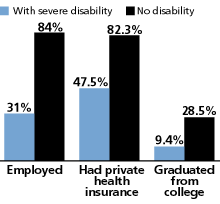
Emerging Trends in Disability
(September 2001) Disability is an ambiguous demographic, but one that is unambiguously increasing. Socioeconomic trends such as aging and other factors have contributed to the growth of the population categorized as disabled, making disability an important issue for policymakers, even though its definition is often a point of contention.
Many sources of U.S. disability data are collected in conjunction with federal beneficiary programs such as Social Security or with state-administered programs in education, vocational rehabilitation, and health care.
The major sources of population data are the National Health Interview Survey (NHIS, conducted by the National Center for Health Statistics) and three data programs of the U.S. Census Bureau: the decennial census, the Current Population Survey (CPS), and the Survey of Income and Program Participation (SIPP). Because the NHIS and SIPP cover a wider range of topics than the decennial census and the CPS, they serve as the primary sources for population research in disability.
The SIPP gathers information on specific functional losses or limitations — for example, inability to lift or difficulty walking — as well as on selected impairments. Disability identification in the NHIS emphasizes limitation in the performance of a major social role, such as working, self-care, or attending school. Key to comparing data from the two surveys is understanding that only a fraction of people reporting functional limits have difficulty fulfilling socially defined roles and that not everybody with an activity limitation has a functional limitation that can be captured in a survey.
Ambiguity in definition notwithstanding, a significant number of Americans live with a disability. In 1997, the prevalence of disability as measured by the NHIS was 13 percent of the noninstitutionalized U.S. population, or 35 million people. Under the broader, functional limits conception of the SIPP, the 1997 rate was close to 20 percent, or approximately 53 million people.
Factors Associated With Increased Disability
Several demographic, socioeconomic, and medical trends, and one major piece of legislation, have direct ties to rising rates of disability:
- Aging. The impact of an aging population on disability prevalence is straightforward. (See the February/March 2001 issue of Population Today.) Nearly three out of four Americans over the age of 80 had a disability in the form of a limitation on a basic functional activity in 1997.
- Poverty. Estimates derived from NHIS data for 1983 to 1996 indicate a significant increase in the rate of childhood disability, from 5.8 percent to 6.8 percent of the noninstitutionalized population under age 21, with virtually all of the increased prevalence attributable to children living in poverty. As both a consequence and cause, poverty has long been linked to disability. In the 1997 SIPP, 28 percent of adults ages 25 to 64 with a severe disability lived in poverty, compared with 8.3 percent for the general population; poverty rates under the NHIS were 27 percent with an additional 19 percent of disabled Americans considered “near poor” (with incomes up to twice the official poverty cutoff). Americans with a disability are at a substantial disadvantage in employment, access to private health insurance, and levels of educational achievement (see figure below).
- Medical Advances. Survival across a wide spectrum of diseases and traumas has improved due to medical advances. For example, survival rates for spinal cord and severe brain injury have dramatically increased in recent decades due to better trauma care. These two forms of injuries account for an estimated 80,000 new people with a disability each year, according to the National Institutes of Health. Similarly, survival rates for low birth-weight infants have increased 70-fold over the past 25 years, directly affecting the prevalence of developmental conditions and learning impairments.
- Emerging Conditions. “Emerging” conditions are syndromes around which there is recent recognition or consensus, such as multiple chemical sensitivity and chronic fatigue syndrome (CFS), or established conditions such as asthma, autism, mental illness, and learning disorders that appear to be growing in prevalence. A common point of dispute is whether reported increases represent growth in actual incidence, greater awareness, and better surveillance, or simply the reduction of stigma in reporting.
Among the recently recognized conditions, prevalence estimates tend to be relatively small and vary widely due to the absence of universal case definitions. For example, physician-based estimates for CFS ranged from 3.8 to 9.6 cases per 100,000 people in an analysis of urban areas done by the Centers for Disease Control and Prevention.
Among the established conditions with recent dramatic changes in prevalence, attention deficit hyperactivity disorder (ADHD) is perhaps prototypical. The number of children identified with the disorder has exploded over the past decade and is now estimated to represent 3 percent to 5 percent of all school age children. It is widely suspected, however, that much of the growth is due to increased awareness and access to improved treatment options. - The Americans With Disabilities Act (ADA). The ADA defines disability as a physical or mental impairment that substantially limits one or more major life activities or as being regarded as having such an impairment. This latter definition takes into account discriminatory decisions based on stereotypes rather than on actual limitations — for example, the presence of facial disfigurement or impairment that does not directly affect performance. In 2000, the U.S. Supreme Court significantly narrowed the interpretation of the definition, ruling that people do not have a disability if impairments can be corrected or do not substantially limit activities.
Disability Status and Economic Disadvantage

Source: Jack McNeil, “Americans With Disabilities: 1997,” Current Population Reports P70-73, February 2001; accessed online at www.census.gov/prod/2001pubs/p70-73.pdf on July 16, 2001.
In 1993, sociologist Irving Zola described the futility of pinpointing the exact size of the population with disability, noting that disability represents “a set of characteristics everyone shares to varying degrees.” There is dynamism in disability status both because of the transitory character of health and because the connection between a person’s impairment and subsequent loss of function is often determined by barriers in his or her physical environment. The legal skirmishes over the definition of disability under the ADA underscore this dynamism, making disability less a concern of medicine and more the province of broadly based civil rights protections.
Glenn T. Fujiura is associate professor and director of graduate studies in the Department of Disability and Human Development at the University of Illinois at Chicago.
References
Vidya Bhushan, Nigel Paneth, and John L. Kiely, “Impact of Improved Survival of Very Low Birth Weight Infants on Recent Secular Trends in the Prevalence of Cerebral Palsy,” Pediatrics 91, no. 6 (1993): 1094-1100.
Centers for Disease Control and Prevention (CDC), “Arthritis Prevalence and Activity Limitations — United States, 1990,” Morbidity and Mortality Weekly Report 43, no. 24 (1994): 433-438.
CDC, “Trends in the Prevalence and Incidence of Self-Reported Diabetes Mellitus — United States, 1980-1994,” Morbidity and Mortality Weekly Report 46, no. 43 (1997): 1014-1018.
Glenn T. Fujiura and Kiyoshi Yamaki, “Trends in Demography of Childhood Poverty and Disability,” Exceptional Children 66 no. 2 (2000): 187-199.
Institute of Medicine, Disability in America: Toward a National Agenda for Prevention, eds. Andrew M. Pope and Alvin R. Tarlov (Washington, DC: National Academy Press, 1991).
H. Stephen Kaye et al., “Trends in Disability Rates in the United States, 1970-1994,” Disability Statistics Abstracts 17 (Washington, DC: U.S. Department of Education, National Institute on Disability and Rehabilitation Research, 1996).
Mitchell P. LaPlante and Dawn Carlson, “Disability in the United States: Prevalence and Causes, 1992,” Disability Statistics Reports 7 (Washington, DC: U.S. Department of Education, National Institute on Disability and Rehabilitation Research, 1996).
Jack McNeil, “Americans With Disabilities: 1997,” Current Population Reports (March 2001): 70-73.
National Center for Health Statistics, Health, United States, 2000 (Hyattsville, MD: Centers for Disease Control and Prevention, 2000).
National Eye Institute, Vision Research — A National Plan: 1999-2003: A Report of the National Eye Advisory Council (Bethesda, Md.: National Institutes of Health, 1998).
National Institutes of Health, “Diagnosis and Treatment of Attention Deficit Hyperactivity Disorder,” NIH Consensus Statement 16, no. 2 (Nov. 16-18, 1998).
National Institutes of Health, “Rehabilitation of Persons With Traumatic Brain Injury,” NIH Consensus Statement 16, no. 1 (Oct. 26-28, 1998).
P.W. Reis, “Prevalence and Characteristics of Persons With Hearing Trouble: United States, 1990-91,” Vital and Health Statistics Series 10 (data from the National Health Interview Survey), no. 188 (1994).
David B. Reuben, Kathleen K. Walsh, and Gail A. Greendale, “Hearing Loss in Community-Dwelling Older Persons: National Prevalence Data and Identification Using Simple Questions,” Journal of the American Geriatrics Society 46, no. 8 (1998): 1008-1011.
Michele Reyes et al., “Surveillance for Chronic Fatigue Syndrome — Four U.S. Cities, September 1989 Through August 1993,” Morbidity and Mortality Weekly Report 46, no. SS-2 (1997): 1-13.
Irving K. Zola, “Disability Statistics, What We Count and What It Tells Us: A Personal and Political Analysis,” Journal of Disability Policy Studies 4, no. 2 (1993): 9-39.






